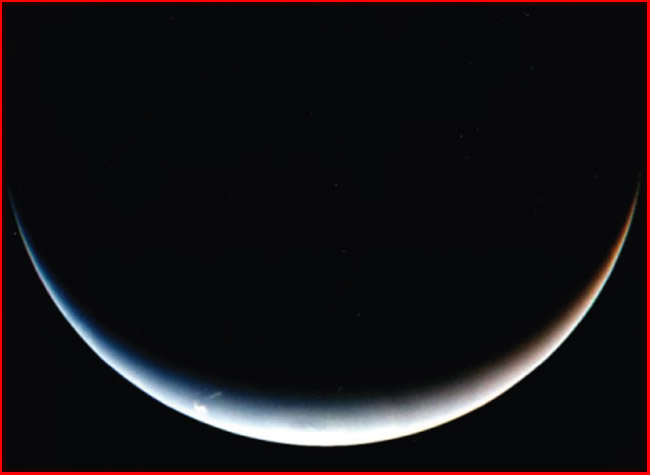
home •
about •
essential guide •
picture of the day •
thunderblogs •
news •
multimedia •
predictions •
products •
get involved •
contact
picture of the day archive subject index
Neptune's South Pole. Credit: NASA/JPL Voyager Mission
Sep 28, 2007
The Hot Pole(s) of Neptune
Neptune's south pole is hotter than the rest of the planet. Could the north pole be just as hot?In a recent announcement by the European Organization for Astronomical Research in the Southern Hemisphere (ESO), scientists studying the surface of Neptune with the Very Large Telescope (VLT) have discovered a ten degree Celsius temperature difference above the rest of the planet's deep cold.
In the prestigious journal Astronomy and Astrophysics, Dr. Glenn Orton et al. write:
"Radiatively-driven elevated temperatures at Neptune's south polar tropopause create an avenue for methane gas transport out of the troposphere where it is effectively segregated by coldtrapping elsewhere on the planet. This should establish a latitudinal distribution of stratospheric CH4 which peaks at the south pole. Its northward gradient will be shallow if the rate of the equatorward transport is more rapid than the rate of downward diffusion. This implies that the seasonally-driven methane leak will be located at its north pole some 80 years from now."
In the standard model of solar system interaction with the sun, thermal radiation is the only mechanism available that can explain the heat coming from Neptune's pole. Because the scientific community does not possess the thermal emission spectra for Neptune from even as short a time as 40 years ago, they are limited to observational evidence collected by recent instrumentation. ESO's VLT, for example, was completed and put online in May of 1998. Neptune's northern summer will have to wait for another 80 years before it can be confirmed that methane is leaking from the north pole. Meanwhile, with measurements of the south-polar summer's methane and temperature variations, the cause is presumed to be the sun heating the entire hemisphere of a gas giant planet 49,500 kilometers in diameter from 4.486 X 106 kilometers away. Presumption would seem to require something more like amazement that such a tiny pinpoint of light in space - little more than a bright star from Neptune's perspective - could stimulate this large effect.
Hot poles and intense electrical aurora have been detected on Saturn, Jupiter, Io, Enceladus and many other celestial objects within the solar system. In past Picture of the Day commentary, the various discharge effects have been shown to be charged plasma. The planets are constantly fed with electrical energy, as the Electric Universe theory posits. The influx of ions generates heat and light - very much like the aurora on Earth, except orders of magnitude larger. It is that connection with the solar heliopause that helps to generate the heating of Neptune's poles.
Another significant observation that has not been included in the published theoretical model of Neptune's polar thermocline, however, is the "hot spots" that can be seen in higher latitudes moving through the stratosphere. The conventional explanation is dismissive in that it sees only the "upwelling of gas" from deeper within the giant planet.
In a previous Thunderbolts Picture of the Day, we took notice of the mysterious white spots, three times larger than Earth, that sometimes appear in the upper atmosphere of Saturn. Our explanation then could be applicable to this observation of "hot spots" on Neptune: electric discharges.
Massive lightning bolts could be going off deep below the clouds on Neptune, creating radio noise and colossal eruptions of ionized gas (plasma) into the upper reaches of its atmosphere. Such lightning discharges could create the electrical conduits, or Birkeland currents, that would allow a direct plasma connection from the planet to space. Thermal imaging equipment sees the tops of such currents coming up from below and interprets them as radiant heat.
Because the phenomena we observe on Neptune have no analogue anywhere else in the solar system, according to ESO scientists, no explanation from conventional theory can be used to make sense of the data. Moving the confirmation of one's hypothesis out to 80 years from now, when Neptune's north pole comes into view, is not the most convenient way to test it. There is a better way to model planetary behavior without resorting to a constant barrage of ad hoc theories created while looking at the display screen.
In the Electric Universe model of Neptune, "hot spots," "hot poles," winds blowing at a thousand kilometers an hour, confined bands of atmosphere with little internal turbulence, and many other actual observations would suggest that we are witnessing an electrically active planet that is part of the circuit connecting the sun and its plasma sheath, the heliopause.
By Stephen Smith
___________________________________________________________________________Please visit our Forum
The Electric Sky and The Electric Universe available now!

|
|

|
EXECUTIVE EDITORS:
David Talbott, Wallace Thornhill
MANAGING EDITORS:
Steve Smith, Mel Acheson
CONTRIBUTING EDITORS: Michael Armstrong, Dwardu Cardona,
Ev Cochrane,
C.J. Ransom, Don Scott, Rens van der Sluijs, Ian Tresman
WEBMASTER: Brian Talbott
Copyright 2007: thunderbolts.info
![]()
home •
thunderblogs •
forum •
picture of the day •
resources •
team •
updates •
contact us

